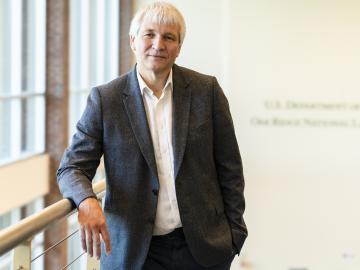
Filter News
Area of Research
News Type
News Topics
- (-) Biology (27)
- (-) Fusion (9)
- 3-D Printing/Advanced Manufacturing (13)
- Advanced Reactors (2)
- Artificial Intelligence (9)
- Big Data (12)
- Bioenergy (23)
- Biomedical (13)
- Biotechnology (7)
- Buildings (10)
- Chemical Sciences (9)
- Clean Water (7)
- Composites (3)
- Computer Science (14)
- Coronavirus (6)
- Critical Materials (2)
- Cybersecurity (6)
- Energy Storage (13)
- Environment (40)
- Exascale Computing (3)
- Frontier (3)
- Grid (7)
- High-Performance Computing (11)
- Hydropower (2)
- Isotopes (13)
- ITER (1)
- Machine Learning (10)
- Materials (9)
- Materials Science (15)
- Mathematics (5)
- Mercury (4)
- Microscopy (11)
- Nanotechnology (6)
- National Security (17)
- Neutron Science (10)
- Nuclear Energy (16)
- Partnerships (2)
- Physics (16)
- Polymers (5)
- Quantum Computing (1)
- Quantum Science (5)
- Security (7)
- Simulation (8)
- Summit (2)
- Transportation (12)
Media Contacts

As the focus on energy resiliency and competitiveness increases, the development of advanced materials for next-generation, commercial fusion reactors is gaining attention. A recent paper examines a promising candidate for these reactors: ultra-high-temperature ceramics, or UHTCs.

Jesse Labbé aims to leverage biology, computation and engineering to address societal challenges related to energy, national security and health, while enhancing U.S. competitiveness. Labbé emphasizes the importance of translating groundbreaking research into practical applications that have real-world impact.
Robert “Bob” Hettich, an ORNL Corporate Fellow, is a pioneer in using mass spectrometry to uncover how microbes interact within complex environments and influence larger systems like plants and humans. A founder of the field of metaproteomics, he leads research that supports bioenergy, environmental resilience and health through advanced protein analysis.
Troy Carter, director of the Fusion Energy Division at Oak Ridge National Laboratory, leads efforts to make fusion energy a reality, overseeing key projects like MPEX and fostering public-private collaborations in fusion research.
Dave Weston studies how microorganisms influence plant health and stress tolerance, using the Advanced Plant Phenotyping Laboratory to accelerate research on plant-microbe interactions and develop resilient crops for advanced fuels, chemicals and

Hugh O’Neill’s lifelong fascination with the complexities of the natural world drives his research at ORNL, where he’s using powerful neutron beams to dive deep into the microscopic realm of biological materials and unlock secrets for better production of domestic biofuels and bioproducts.

The Advanced Plant Phenotyping Laboratory at ORNL utilizes robotics, multi-modal imaging, and AI to enhance understanding of plant genetics and interactions with microbes. It aims to connect genes to traits for advancements in bioenergy, agriculture, and climate resilience. Senior scientist Larry York highlights the lab's capabilities and the insights from a new digital underground imaging system to improve biomass feedstocks for bioenergy and carbon storage.

Brian Sanders is focused on impactful, multidisciplinary science at Oak Ridge National Laboratory, developing solutions for everything from improved imaging of plant-microbe interactions that influence ecosystem health to advancing new treatments for cancer and viral infections.

John Lagergren, a staff scientist in Oak Ridge National Laboratory’s Plant Systems Biology group, is using his expertise in applied math and machine learning to develop neural networks to quickly analyze the vast amounts of data on plant traits amassed at ORNL’s Advanced Plant Phenotyping Laboratory.

Howard Wilson explores how to accelerate the delivery of fusion energy as Fusion Pilot Plant R&D lead at ORNL. Wilson envisions a fusion hub with ORNL at the center, bringing together the lab's unique expertise and capabilities with domestic and international partnerships to realize the potential of fusion energy.


